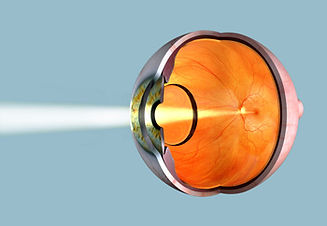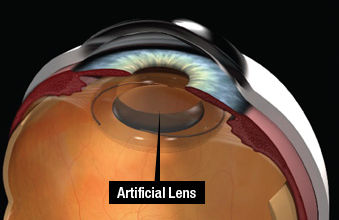Cataract
Eye Conditions
Cataract
CSCR
Diabetic Retinopathy
Epiretinal Membrane
Flashes and Floaters
Glaucoma
Macular Degeneration
Macular Hole
Retinal Detachment
Retinal Vein Occlusion
Uveitis
Vitreomacular Traction
Investigations
Procedures
Cataract refers to fogging or clouding of the crystalline lens. Vision gradually becomes more blurry, and images lose clarity and colour. You may feel more glare on bright sunny days and lights may appear streaked at night.

Light entering the eye is normally focused on the retina when the lens is clear.

Normal Vision

When cataract has developed, the clouded lens scatters light, causing vision to deteriorate.

Vision with Cataract
Mild cataract can be managed with glasses, but if the lens becomes sufficiently cloudy, surgery is the only practical treatment. Modern cataract surgery (called phaco) is performed under local anaesthesia with minimal discomfort. Sutures are rarely required. Laser can be used to help make the wounds but phaco is still necessary.

A circular opening is made in the skin (capsule) covering the clouded lens. The lens is broken up using ultrasound and vacuumed out.

Artificial lens is inserted into the now empty capsule, which serves as the holder for the new lens.

Please follow the link to find out more about Cataract Surgery
What is cataract?
Cataract refers to clouding of the crystalline lens. This reduces the vision and makes colours appear washed out. It also causes bright objects to appear streaked or glary and will make it difficult for you to distinguish different shades of grey. The word 'cataract' actually means 'waterfall' in Greek, and the vision may be described as if looking through a curtain of water. Many patients with early cataract notice that their reading vision improves. This is because the cataract makes the lens denser and shifts the focus to near (that is, the eye becomes short-sighted). Some people actually find this short-sightedness useful, but eventually, the clouding of the lens will reduce the vision.
Who are affected?
Cataract usually begins to develop after 50 years of age, but in most people, it does not become significant until later in life. It is possible for cataract to develop in children and young adults, due to underlying eye problems or injury. Rarely, some infants are born with congenital cataract due to problems during pregnancy or inborn metabolic disorder.
What causes cataract?
Cataract in older people develops as a result of life-long exposure to sunlight and consequences of metabolism. Both sunlight exposure and metabolism ('burning of nutrients') lead to formation of harmful by-products, which can cause the proteins in the crystalline lens to change structurally, much like iron rusts in air. Smoking causes cataract formation to accelerate by producing more harmful by-products.
In younger people, cataract can develop in association with severe inflammation of the eye, diabetes, injuries or after taking medication. Some infants are born with cataract due to known problems during pregnancy, but other babies are perfectly well and the cause of the cataract can remain unknown.
How is cataract diagnosed?
Cataract is readily diagnosed during an eye examination, by noting the clouding of the lens through the examination microscope. However, a complete examination of the eye is important to rule out other possible causes of vision loss. If surgery is planned, measurements of the length of the eye and curvature of the cornea will be taken to calculate the power of the artificial lens required to replace the natural lens.
When should cataract be removed?
A mild cataract that causes few symptoms do not require treatment. Delaying the cataract surgery does not reduce your chance of regaining good vision. However, if the cataract is allowed to get too dense, the surgery can become technically more challenging and involve higher risk. You should consider surgery if you find your vision to be inadequate for activities you wish to pursue.
How is cataract treated?
Early cataract may not require surgery. Updating your glasses and wearing sunglasses may be enough to control the symptoms of cataract.
Modern Cataract Surgery is performed through tiny wounds made along the edge of the cornea, which do not require stitches. A circular opening is made on the front face of the lens capsule (the skin that wraps the lens crystals). An ultrasound probe is inserted into the eye to break up the lens into small pieces and remove them using suction. An artificial lens is inserted into the now empty capsule, which holds the artificial lens in the correct position. Laser-assisted cataract surgery uses laser to create the wound and capsular opening, but ultrasound probe is still needed to remove the cataract. This new technique has not yet been shown to improve visual outcome.
Advances in intraocular lens technology means there are options for lens choices. Astigmatism can be corrected as well as near or far sightedness, which must be taylored to the individual needs. Multifocal lenses bring advantages as well as compromises, which needs to be discussed thoroughly with your surgeon.
What are the benefits and risks of cataract surgery?
Modern cataract surgery is highly successful in restoring the sharpness and clarity of vision. There is little discomfort after surgery and most patients make a rapid recovery.
As with all surgeries, complications can occur but the overall risk is low:
More common: lens capsule tear, poor artificial lens position, wound leakage, corneal swelling, macular swelling, capsule clouding
Less common: retinal detachment, incomplete removal of lens
Rare: infection, severe bleeding, wrong lens power